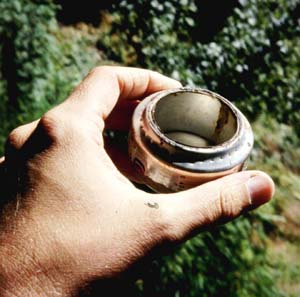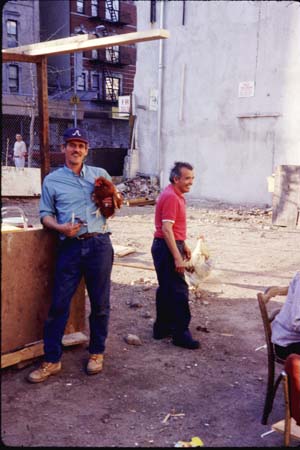|
|


suburban baroque
We’re driving around the confused fractal street scapes of a night-time suburbia when we came across an eerie aura glowing above a neighbouring cul-de-sac. We pull in and join a procession of cars solemnly crawling past split-level houses completely encrusted with seemingly trillions of multicoloured lights in a kind of Jack Smith meets Thomas Edison, American, kitsch rococco kind of landscape of the insane. Simulacrum snowmen flash-frozen while playing hockey. Did they look at the distant mall and get turned to pillars of plastic? An animatronic, bulb festooned, wire frame deer cocks its head at 30 second intervals, a thousand blinding and strobing incandescent bulbs exhort anonymous idling vehicles to have a *Merry Christmas* I become oddly nostalgic, as I remember my own father long ago, driving our family through similarly phantasmagoric displays of conspicuous uberwattage, on bleak pre-Christmas nights, deep within the vast street-maze of Toronto’s bedroom suburbs. As a child, I felt deeply comforted by the familiarity of schlock. I guess that is the allure of Disney. Like a motel toilet seat, reality has been ‘sanitized for your protection.’ And in suburban North America, the landscape itself has become a theme park. Micheal Sorkin edited an intriguing series of essays on this topic in his (1992) Variations on a Theme Park.
I guess we want to keep out the darkness at this time of year, which is always around the corner. But darkness can also be a great comfort, a kind of buffer against the shrillness of existence. Junichiro Tanizaki expounds on this in his exquisite extended (1933) essay, In Praise of Shadows Back in the 1930’s, Tanizaki was lamenting the aesthetic impact of the onslaught of an electrified modernity, but of course these days, Japan is anything but dark. Nuclear power took care of that.
Shohei Imamura is the filmmaker that for me best captures Japan’s uneasy post-war lurch into modernity, in particular the films Insect Woman, The Pornographers and especially his (1961) Pigs and Battleships otherwise known as The Flesh is Hot
And speaking of *flesh*, Mad Cow has finally been detected in the USA, despite having been there all along if, like me, you ascribe to the theory that John Stauber promulgates in his (1997) Mad Cow USA (now, incidentally available as a free download). Stauber has been keeping us well appraised of the developments. For example, he sent us a copy of an e-mail he received from organic dairy farmers Jim and Rebecca Goodman in Wisconsin, who were recently visited by a salesman selling blood-based cattle feed, which of course is a perfect vector for spreading more Mad Cow disease. Things in the American (and Canadian) food production systems have been systemically rotten for years and one can only hope that the shit will finally hit the fan over agribusiness-induced mad cow disease and its incurable human variant: Creutzfeld-Jacob. But hey, “the American system was never intended to keep sick animals from reaching the public’s refrigerators”, said Dr. Ron DeHaven, the Agriculture Department’s chief veterinarian in the New York Times. Stauber includes an image of the feed flyer which I am reproducing here. Note the plasma and serum ingredients. One way or another, a lot of beef-eating North Americans should be getting pretty *mad* this Christmas.

Once again I am technological meltdown mode. My I-book crashed and is off in the shop. . .
It turns out that some of Apple’s I-books have a design flaw, which causes the video chip to short out against the inside of the case, when the laptop gets *moved*.
Aren’t laptops supposed to get moved? Anyway, I’m reduced to blogging on the communal computer without (sigh) my bookmarks, or files.
So, I get to watch way more TV, and grow increasingly more apoplectic.
A case in point:
BBC World reported last week that gangsters in the Russian Far East are directing and producing big budget gangster movies starring- *themselves* AND, they use real bullets. I guess there is a lot of respect for the institution of authenticity in contemporary Russian film. Not even Godard could have come up with this interesting twist on Kino, but BBC World’s web site is so impenetrable and Byzantine, I couldn’t snag the link. .
PBS’s NOW reports that the National Rifle Association is mobilizing to buy up radio and television stations to get its “political message across” and to escape new rules, preventing groups that take corporate or union money from buying certain types of political ads on radio or TV 30 days before a primary or 60 days before a general election. It’s so much easier to buy a whole TV station than just some little old ad. Maybe those guys from the Russian Mafia could find a market for their films on “NRA TV.” Russia and America have so much more in common now that the Cold War is over. The NRA is even prepared to launch *pirate* radio stations from ships at sea to make Americans buy more guns. (I wonder if they’ll fly the skull and crossbones flag?)
Blogger has developed a weird new bug which *vaporizes postings* that I have been working on in draft mode. (Time to jump to Moveable Type !) I hope they get it fixed soon or I will really truly bail. I’m sure glad I’m composing in BBEdit . . .
I was pleasantly surprised to receive a few copies of the new Walrus magazine. I’m embarrassed to say that I stopped reading most Canadian magazines because they became so parochial and preachy, but Walrus is great ! The inaugural issue features a wonderful review by Lewis Lapham of the film McLuhan Reloaded, an homage to garbage by Douglas Coupland, an article on Tel Aviv becoming a Bauhaus World Heritage Site, and tons of other interesting stuff. I’m subscribing! So far, Walrus stacks up pretty nicely against the New Yorker and Harpers and it even has an easy to navigate website. And it’s *Canadian*
The folks over at travelersdiagram have been kind enough to link to my blog. Travelersdiagram links to a lot of amazing blogs. One of my favourites is geisha asobi who always has some very *whacked* links. This week she links (among many others) to J-Walk’s blog, who in turn links to the Connected Thesaurus which is extremely useful. Check out his links to an amazing image gallery called colofinder in which
aerial views of nuclear weapon storage areas caught my eye, as did the heavily visited messy cables.

Tent city in Vancouver 2003
It is of course abundantly obvious, that the much vaunted ‘market mechanism’ of late capitalism can’t or won’t provide even basic shelter for many living in our urban areas, regardless of the supposed employment rate or the “health of the economy.” I only need think back to 30 or so years ago, to when I was a kid growing up near Toronto. Visible homelessness then was more or less limited to a narrow demographic consisting of elderly substance-abusing men. Last time I visited Toronto, I saw entire families with children camped out over the hot air grates of the ultimate *cold city.* Vancouver is no better and tent cities have sprung up all over. The new economic brutalism is marginalizing an ever increasing portion of our population and there seems to be very little resolve by governments to do anything about it. In fact, visible homelessness has become a great tool for scaring the working poor into compliance with the Walmart economy. A case in point is British Columbia’s recent decision to cut 80,000 people off of the welfare roles by 2004, which the CBC predicts will result in 6,000 to 8,000 more people on the streets.
Let’s face it. It’s not impossible for most of us to imagine being homeless. What – with a bit of bad luck, and without a support network of family and friends, it might be closer than you think!
So, what to do? How can housing be constructed cheaply enough so that it can be *owned* by the rapidly increasing segment of our population that constitutes the *domestic third world*.
There has been some interesting thinking about this problem among architects lately, and a group working in Tokyo has come up with a very cool modular dwelling made completely out of polycarbonate plastic i.e, the cheap corrugated stuff that (ironically) real estate signs are often made of. While they quote a price of 350.000 yen (about $4300 CAN) to build one, I am sure it could be done much more cheaply in North America, as the Japanese prices for materials tend to be high. For less money than it costs for the government to subsidize slum landlords, the homeless could be given the materials and instructions on how to build these houses and be offered a safe place put them. What a radical idea! Home ownership for the homeless! These plastic houses can be built with just a box cutter, a saw and a screwdriver *and* they are completely portable.
Of course you need to be able to cook. Last summer, a student of mine, (A.K.A. Windy Day), showed me how to construct these lovely and highly efficient little rocket stoves out of discarded tin cans. The larger model burns sticks and pieces of paper extremely efficiently, and it is possible to boil water quickly with a minimum use of fuel. The smaller “pocket rocket” is made out of the bottom of a tomato paste can, jammed inside an aluminum beer can, which is crimped over and has tiny holes poked through it with a pin (see pictures). This little stove burns methyl hydrate (a common solvent) and can heat water in just a few minutes. The whole thing can fit in coat pocket:

“rocket” stove (burns sticks and scrap paper)

“pocket rocket” (burns methyl hydrate)
If your stuck in an economic refugee camp, why not start your own pirate FM radio station? Tetsuo Kogawa shows you how to build a neat little low power pirate transmitter for just a few dollars. I built one some years ago and it is so-o-o fun! The transmissions can be picked up on any conventional FM radio, (car, clock radio, whatever) and the range seems to be about 2 km. *Networks* of these little transmitters can be created, by connecting the earphone ‘out’ signal of a receiver (tuned to the pirate station), to the audio input of another pirate transmitter – thereby increasing the range indefinitely. This has classic bootstrapping potential !
“L’anarchie ! . . . .
I came face to face with a red-tailed hawk yesterday, that had just killed one of my chickens and had inadvertantly snagged itself in the net fence surrounding the coop. A magnificent bird, it gave me the most piercing stare as I struggled to free it from its entanglement, *carefully* avoiding its rapier-like talons and snapping, razor sharp beak. That purposeful and unflinching pair of eyes momentarily connected me with a much older and deeper level of cognition, that of “bird mind”. Birds of course are what the dinosaurs evolved into, and yet they are capable of astonishing feets of cognition, governed by a neural chassis utterly alien to our own.
James Blish imagined what a world would be like if bird cognition evolved into a planet’s dominant culture, in his (1972) Midsummer Century:
The next day they saw three more of the sparrow-like birds, and the next day, five. And the morning after that, they emerged from their sleeping burrow to find a smoke-black thing like an enormous crow looking down upon them, just out of club’s reach, its head bent, its neck extended until it seemed almost snakelike; its eyes glassy and unblinking. . . . For very disparate reasons, neither of the two minds was surprised when the bird’s beak parted, its throat ruffled and pulsed, and it said in a voice like fingernails on a blackboard:
“GO HOME.”
Upon being released, the red-tailed hawk flapped lazily up to the nearest tree and continued to stare down hungrily at the panic-stricken flock of silkies, not having been distracted in the least from its original mission. Oh to have even a *fraction* of the focus of a red-tailed hawk. Of course they don’t get distracted by blogging . . .
The fat little chicken that the hawk was after, was indeed an attractive target. Bred and morphed by our species for millenia, chickens are the ultimate symbiots, originally sharing the tropical forest edge habitats we lived in, when they were first domesticated over 8,000 years ago, in southeast Asia. Ever since, chickens have provided us with eggs, meat, fertilizer, wake up service and garbage disposal, in return for our protection and a few handfuls of grain. This arrangement has proven to be pretty good for humans, although not always for individual chickens, especially if they wind up in cock-fights or factory farms. Still, properly looked after, chickens are supremely useful, portable and fun and keeping them makes you feel, well *self-sufficient* You don’t have to kill them to benefit because they lay EGGS. Chickens are a particularly useful creature in urban contexts, literally providing the *means of production* to turn garbage into protein, though keeping them is frowned upon by many municipalities.
When I was living in New York’s Lower East Side, I was elated to come across some fellow hardcore poultry zealots, in the form of these Puerto Rican men, with whom I could talk a little chicken. I loved hearing the crowing of roosters over the din of the Manhattan traffic, knowing that the chicken men were in their own small way, committing an act of revolution.

Loisida Chicken men
I suppose blogging is kind of like fishing – you never know who will nibble. I was so-o-o excited to be linked to by a website on underwater sound; specifically in their underwater *sound fixing and ranging * (SOFAR) pages. Check out the high speed videos of snapping shrimp, which document how shrimps make snapping sounds through *cavitation bubbles*
And speaking of *snapping*, what is *up* with consensual cannibalism? Is it just me or is this the weirdest thing to come down the BBC news pipe for a long time? There’s something about the *juxtaposition* of those two words. Apparently, Armin Meiwes, the German who is standing trial for eating an acquaintance, has advised others not to follow his example. Well . . . . All right then!
The Austrian artist Ervin Wurm frequently riffs on these strangely Germanic notions of engulfing and bloating. I caught a show of his last year at MassMoCA and snapped this pic of one of his installations.

Erwin Wurm installation
One of my great pleasures (when I occasionally get off of my *tiny windswept island*) is to be able to power-watch piles of DVD’s of films that I missed, when they were theatrically released. To do this, I have to travel to Victoria. Most of the other towns between here and there are grim industrial sorts of places, which look like they’ve been ‘twinned’ with Vladivostock (say) or Novosibirsk. Their skylines consist of enormous pulp mills, spewing vast plumes of carcinogenic smoke into the local airsheds, surrounded by mountains that look like they are coming out of chemotherapy- their forests torn off in huge patches of clearcut logging.
Victoria on the other hand is affectionately known as “the tweed curtain” due to to its oddly endemicized anglophilia. More like Torquay than BeeCee, Victoria boasts a peculiarly temperate microclimate, replete with palms and eucalyptus trees, which look rather dissonant within the context of the outwardly nordic landscape.
This virtual England also has double-decker buses and an enormous population of retirees.

Chinese fan palm in Victoria BC
A trip to the local independent video store yielded a couple of gems: Agnes Varda’s (2000) documentary paean to food recycling called ‘The Gleaners’ as well as Wang Xiaoshua’s (1998) bleak Chinese noir film, ‘So Close to Paradise’. Varda of course is the doyenne of the French nouvelle vague and ‘The Gleaners’ represents a later stage work, which is both sentimental and fascinatingly tangential. For example, Varda works a narrative about Etiene-Jules Marey, the French father of chronophotography (predating Edvard Muybridge) into a story about finding discarded heart-shaped potatos at a dump. Varda comes across as a kinder, gentler more humanistic Chris Marker but she shares his overt intimacy with the camera (which almost becomes a character in their films) and they both track discursive narratives relentlessly and unapologetically. Varda (like Marker) is truly a blog filmmaker. And they both like cats . . . .
Wang Xiaoshua (one of the PRC’s so called ‘sixth generation’ filmmakers) has produced, in ‘So Close to Paradise’ (and later, ‘Beijing Bicycle’), films that ‘out noir’ NOIR, yet don’t lapse into the stultifyingly puerile hystrionics of Quentin Tarantino and his ilk. Tarantino’s work can’t hold a candle to that of Xiaoshua’s or Hong Kong’s Wong Kar-Wai (who made Chungking Express, Fallen Angels etc.) – and what is even *more* amazing is that Xiaoshua was able to make his films in a climate of strict censorship and repression. ‘So Close to Paradise’ was banned by Chinese censors for 3 years because of its portrayal of the problems facing modern China, yet Xiaoshua still managed to move doggedly forward, making films under a pseudonym. The film scene in China is full of such fascinating, hard-core auteurs and I vowed to waste no more time watching the lame and bloated offerings of an increasingly irrelevant Hollywood.
I recall seeing a panel discussion at the Hawaii International Film Festival in 1995, where Zhang Yimou, Hou Hsiao-Hsien and several other PRC filmmakers were being pressed by sycophantic American journalists to admit ‘how hard it must be to work under state censorship’ without the ‘freedom’ enjoyed by American filmmakers. The filmmakers replied (and I’m paraphrasing here) that, while their situation in China was not without enormous challenges, at least they weren’t burdened by the censorship of the North American marketplace, where it has become nearly impossible to raise money for any major project that isn’t completely banal and formulaic.
And speaking of formulas: the BBC’s Earth Report ran a story recently which examined the correlation between environmental degradation and genocide in Rwanda and elsewhere. In the program, Mark Halle (Project Coordinator of Environment and Security at the International Institute of Sustainable Development) said:
“We did a very interesting case study in Rwanda, looking at the origins of the genocide in 1994 and in fact we found that there was a perfect correlation those parts of the country that were most degraded and the areas where the conflict originated. Now that’s not to say that environment was the cause of the Rwandan genocide. But it’s certainly a contributing factor.”
Earthwatch goes on to say:
The link between environmental degradation and global security has become such a pressing issue that the United Nations Environment Programme and the United Nations Development Programme are working on a joint project with two bastions of international security: the Organisation for Security and Cooperation in Europe, and NATO. The result of this partnership is the Environment and Security Initiative, known as ENVSEC. Its working on a pilot project in Central Asia and South Eastern Europe – a region where resource scarcity, ethnic tension and weak civil society have combined all too frequently to spark off conflict.
Earth Report closes with some footage of abandoned fishing boats resting on the dry bed of the now vanished Aral Sea. From this *single biggest environmental catastrophe on the planet*, blow clouds of pesticide contaminated dust, causing an epidemic of anemia, liver and thyroid disease as well as cancer, giving the area the highest child mortality rate in Russia. The image of sick and impoverished Cental Asian children playing among stranded fleets of rusting fishing vessels, in the middle of this vast, man-made desert, is for me one of the defining icons of the failure of modernity.
|
|











